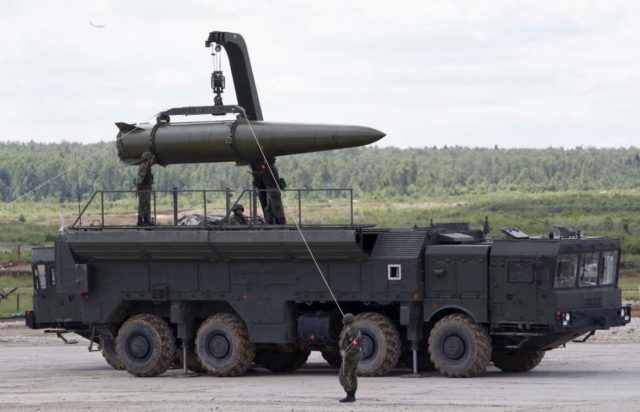
Russia’s Land-Based Cruise Missiles as a Political Tool
Publication: Eurasia Daily Monitor Volume: 17 Issue: 156
By:

With future prospects for the nuclear arms control regime uncertain and the Kremlin unable to play its traditional political game of summitting with Western leaders due to the COVID-19 pandemic and international condemnation of Russia’s violations of the chemical weapons ban treaty, Russian President Vladimir Putin has proposed “de-escalation in Europe.” Namely, Moscow declared a readiness to withdraw its 9M729 land-based cruise missiles—those which led to the collapse of the 1987 Intermediate-Range Nuclear Forces (INF) Treaty (see EDM, January 22)—from the European part of Russia in exchange for a comparable moratorium on members of the North Atlantic Treaty Organization (NATO). Moreover, Putin proposed foreign inspections of its land-based missile brigade in Kaliningrad Oblast in return for inspections of the United States’ Aegis Ashore missile-defense bases in Europe (Kremlin.ru, October 26). Russia contends that these missile-defense systems may be converted into launchers of offensive Tomahawk long-range cruise missiles (RBC, February 1, 2019; see EDM, December 6, 2018). Even though Putin’s initiative is presented as a Russian concession, the main reason for this proposal is Russia’s long-term goal of affirming itself as a second (after the US) but inevitable guarantor of European security.
The main issue regarding the 9M729 cruise missile is not its technical specifications. Russian officials claim that the only differences between this new weapon and its predecessor—the 9M728 missile, developed in the 2000s, which did not violate the collapsed INF Treaty—are more sophisticated guidance systems, more powerful (under-500-kilometer-range) warheads and their respective launchers (Mil.ru, January 23, 2019). Rather, the top concern to the US and NATO is that these land-based cruise missiles are clearly and exclusively offensive weapons.
The speed of the 9M729 cruise missile is 8–10 times slower compared to 9M723 tactical ballistic missiles—the main weapon of the Russian Ground Forces’ missile brigades armed with the Iskander-M mobile theater missile launcher. Moreover, the new cruise missile’s nap-of-the-earth (NOE—i.e., very low altitude flight) mission profile is more sophisticated than the mission profile of ballistic missiles and takes more time to plan out. Consequently, while tactical ballistic missiles may be used against both stationary objects and enemy troops columns in minutes, cruise missiles may take tens of minutes to strike targets that, as a result, must be stationary. Because of this, the 9M729 cruise missile only makes sense if its range significantly exceeds the 400–500 km range of the 9M723 tactical ballistic missile or 9M728 cruise missile. Moreover, being dual capable, these missiles increase uncertainty in the European theater and aim to create additional political pressure on the US’s European allies, reminiscent of the 1960s–1980s, and to drive a wedge between them.
Such political benefits notwithstanding, the original reason for Russia’s emphasis on developing ground-based cruise missiles is the long-term weakness and vulnerability of the country’s surface navy. The typical Iskander-M missile brigade can launch 24 missiles at one time: each of its 12 launchers (2 battalions, 6 launchers in each battalion) carries 2 missiles, regardless of whether the brigade is armed with 9M723 tactical ballistic missiles only or a mix of the ballistic missiles and 9M728 cruise missiles. However, if the brigade consists of one battalion of 9M723 ballistic missiles (even if mixed with 9M728 cruise missiles) and one battalion of 9M729 cruise missiles, it can launch up to 36 missiles at one time because each special launcher for the advanced cruise missiles carries 4 of them (Dfnc.ru, January 27, 2019). This is still a significantly smaller barrage than, for instance, what a typical US guided-missile destroyer is capable of launching; but it is more than each of the most advanced Russian frigates has (8–16 missiles). At the same time, Russia’s 13 land-based missile brigades are less vulnerable to the enemy’s counteract than a handful of frigates, and they may be quickly reloaded for their second salvo. Therefore, Moscow has spent many years trying to convert its conventional military weakness into an asymmetric advantage. This approach benefits Russia’s foreign policy toward the United States and Europe as well as for Russia’s hedging or implicit deterrence policies toward its neighbors in East Asia, China and North Korea (see Pavel K. Baev, “Russia’s Arctic and Far East Strategies,” Russia’s Military Strategy and Doctrine, The Jamestown Foundation, February 2019).
Two Russian missile brigades currently threaten NATO members: the 152nd Guard Missile Brigade (Kaliningrad region) and the 26th Missile Brigade (Leningrad region), both of which have conventional strike and potential non-strategic nuclear weapons capabilities. Logistics considerations imply that a permanent deployment of 9M729 cruise missiles is much more probable and convenient for the brigade based in Leningrad Oblast than in the Kaliningrad exclave. So even if Putin’s proposed withdrawal of 9M729 cruise missiles from the European part of Russia actually becomes realized, in practice that will mean only a reversible reduction of deployed missiles there—but notably not the reduction of locally based missile brigades themselves or the elimination of infrastructure for nuclear weapons in western Russia. Moreover, establishing working verification measures for such a reduction seems practically impossible.
For all these reasons, the Kremlin is not taking seriously its own “de-escalation proposal.” Similarly, it is difficult to believe that Russia genuinely believes its allegations that the US could covert its land-based strategic missile-defense systems in Europe into Tomahawk launchers since this would make little military sense. Nevertheless, Moscow wants to assert its role as a guarantor of European security, and Western agreement to inspections of the Aegis Ashore bases in Romania and Poland (after the latter one becomes operational) would inherently become a valuable diplomatic asset for Russia’s leadership. The Kremlin proposal is only a trial balloon, but one specifically designed to test the level of solidarity among NATO allies through a classic carrot-and-stick approach. Indeed, Moscow’s long-term goal remains to weaken the mutual confidence among North Atlantic Alliance members regarding issues of collective defense.



